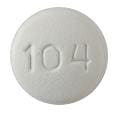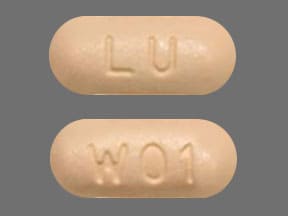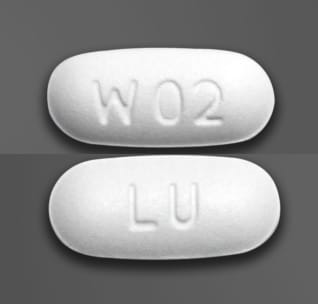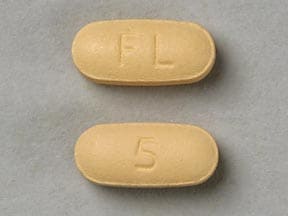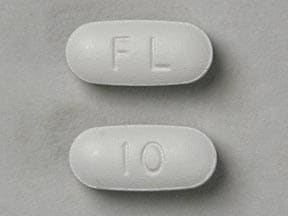Dosage Forms
Excipient information presented when available (limited, particularly for generics); consult specific product labeling. [DSC] = Discontinued product
Capsule Extended Release 24 Hour, Oral, as hydrochloride:
Namenda XR: 7 mg, 14 mg, 21 mg, 28 mg
Namenda XR Titration Pack: 7 mg (7s) and 14 mg (7s) and 21 mg (7s) and 28 mg (7s)
Generic: 7 mg, 14 mg, 21 mg, 28 mg
Solution, Oral, as hydrochloride:
Namenda: 10 mg/5 mL (360 mL [DSC]) [peppermint flavor]
Generic: 2 mg/mL (240 mL, 360 mL); 10 mg/5 mL (5 mL)
Tablet, Oral, as hydrochloride:
Namenda: 5 mg [contains fd&c blue #2 (indigotine), fd&c yellow #6 (sunset yellow)]
Namenda: 10 mg
Namenda Titration Pak: 5 mg (28s) and 10 mg (21s) [contains fd&c blue #2 (indigotine), fd&c yellow #6 (sunset yellow)]
Generic: 5 mg, 10 mg, 5 mg (28s) and 10 mg (21s)
Pharmacology
Mechanism of Action
Glutamate, the primary excitatory amino acid in the CNS, may contribute to the pathogenesis of Alzheimer's disease (AD) by overstimulating various glutamate receptors leading to excitotoxicity and neuronal cell death. Memantine is an uncompetitive antagonist of the N-methyl-D-aspartate (NMDA) type of glutamate receptors, located ubiquitously throughout the brain. Under normal physiologic conditions, the (unstimulated) NMDA receptor ion channel is blocked by magnesium ions, which are displaced after agonist-induced depolarization. Pathologic or excessive receptor activation, as postulated to occur during AD, prevents magnesium from reentering and blocking the channel pore resulting in a chronically open state and excessive calcium influx. Memantine binds to the intra-pore magnesium site, but with longer dwell time, and thus functions as an effective receptor blocker only under conditions of excessive stimulation; memantine does not affect normal neurotransmission.
Pharmacokinetics/Pharmacodynamics
Absorption
Well absorbed
Distribution
9 to 11 L/kg
Metabolism
Partially hepatic, primarily independent of the CYP enzyme system; forms 3 metabolites (minimal activity)
Excretion
Urine (74%; ~48% of the total dose as unchanged drug; undergoes active tubular secretion moderated by pH-dependent tubular reabsorption; excretion reduced by alkaline urine pH)
Time to Peak
Serum: Immediate release: 3 to 7 hours; Extended release: 9 to 12 hours
Half-Life Elimination
Terminal: ~60 to 80 hours
Protein Binding
45%
Use in Specific Populations
Special Populations: Renal Function Impairment
Mean AUC0-∞ increased by 4%, 60%, and 115% in patients with mild, moderate, and severe renal impairment, respectively. The terminal elimination half-life increased by 18%, 41%, and 95% in patients with mild, moderate, and severe renal impairment, respectively.
Special Populations: Hepatic Function Impairment
Terminal elimination half-life increased by ~16% in patients with moderate hepatic impairment.
Special Populations: Gender
Women had ~45% greater exposure than men; however, there was no difference in exposure when body weight was taken into account.
Use: Labeled Indications
Alzheimer disease: Treatment of moderate to severe dementia of the Alzheimer type.
Use: Off Label
Vascular dementia (mild to moderate)cyes
Data from two meta-analysis evaluating two randomized, double-blind, parallel-group, placebo controlled trials suggest that memantine may be beneficial for the treatment of mild to moderate vascular dementia based on a small, statistically significant effect on cognitive function. However, no significant difference was identified for clinical global ratings of change, suggesting cognitive improvements may not be clinically detectable. Additional data is necessary to further define the role of memantine in this condition.
Based on the American Psychiatric Association practice guidelines for the treatment of patients with Alzheimer Disease and other dementias, memantine given for vascular dementia is not supported by the evidence and further trials are needed.
Contraindications
Hypersensitivity to memantine or any component of the formulation
Dosage and Administration
Dosing: Adult
Alzheimer disease, moderate to severe: Oral:
Immediate release: Initial: 5 mg daily; increase dose by 5 mg daily (if previous dose well tolerated) to a target dose of 20 mg daily; wait ≥1 week between dosage changes. Doses >5 mg daily should be given in 2 divided doses. Note: If treatment is interrupted for longer than several days, the treatment may need to be restarted at a lower dose and retitrated.
Suggested titration: 5 mg daily for ≥1 week; 5 mg twice daily for ≥1 week; 15 mg daily given in 5 mg and 10 mg separate doses for ≥1 week; then 10 mg twice daily
Extended release: Initial: 7 mg once daily, increase dose by 7 mg daily to a target maximum dose of 28 mg once daily; wait ≥1 week between dosage changes (if previous dose well tolerated)
Note: When switching from immediate release product to the extended release product, begin the extended release product the day after the last dose of the immediate release product. Patients on immediate release 10 mg twice daily should be switched to extended release 28 mg once daily.
Missed dose: If a single dose is missed, do not double up on the next dose; take the next dose as scheduled. If several days of dosing are missed, dosing may need to be resumed at lower doses and retitrated.
Vascular dementia, mild to moderate (off-label use): Oral: Immediate release: Initial: 5 mg once daily; titrate in increments of 5 mg daily each week to a target dose of 10 mg twice daily (Orgogozo, 2002; Wilcock 2002). Additional data may be necessary to further define the role of memantine in this condition.
Dosing: Geriatric
Refer to adult dosing.
Administration
Administer without regard to meals. Extended release capsules may be swallowed whole or entire contents of capsule may be sprinkled on applesauce and swallowed immediately; do not chew, crush, or divide. Withdraw and administer oral solution with provided dosing device; dose should be slowly squirted into the corner of the patient’s mouth. Do not mix oral solution with any other liquid. The Canadian labeling recommends tablets to be swallowed whole with water.
Storage
Capsule (extended release): Store between 20°C to 25°C (68°F to 77°F).
Tablet, oral solution: Store at 25°C (77°C); excursions are permitted between 15°C and 30°C (59°F and 86°F).
Memantine Images
Drug Interactions
Alkalinizing Agents: May increase the serum concentration of Memantine. Monitor therapy
Benperidol: Memantine may diminish the therapeutic effect of Benperidol. Monitor therapy
Carbonic Anhydrase Inhibitors: May increase the serum concentration of Memantine. Exceptions: Brinzolamide; Dorzolamide. Monitor therapy
Erdafitinib: May increase the serum concentration of OCT2 Substrates. Monitor therapy
NMDA Receptor Antagonists: May enhance the adverse/toxic effect of Memantine. Monitor therapy
Tafenoquine: May increase the serum concentration of OCT2 Substrates. Management: Avoid use of OCT2 substrates with tafenoquine, and if the combination cannot be avoided, monitor closely for evidence of toxicity of the OCT2 substrate and consider a reduced dose of the OCT2 substrate according to that substrate's labeling. Consider therapy modification
Trimethoprim: May enhance the adverse/toxic effect of Memantine. Specifically, the risk of myoclonus and/or delirium may be increased. Trimethoprim may increase the serum concentration of Memantine. Memantine may increase the serum concentration of Trimethoprim. Monitor therapy
Adverse Reactions
Adverse reactions similar in immediate and extended release formulations except as noted.
1% to 10%:
Cardiovascular: Hypertension (4%), hypotension (extended release: 2%)
Central nervous system: Dizziness (5% to 7%), confusion (6%), headache (6%), anxiety (extended release: 4%), depression (extended release: 3%), drowsiness (3%), hallucination (3%), pain (3%), aggressive behavior (2%), fatigue (2%)
Endocrine & metabolic: Weight gain (extended release: 3%)
Gastrointestinal: Diarrhea (5%), constipation (3% to 5%), vomiting (2% to 3%), abdominal pain (2%)
Genitourinary: Urinary incontinence (2%)
Infection: Influenza (4%)
Neuromuscular & skeletal: Back pain (3%)
Respiratory: Cough (4%), dyspnea (2%)
<1%, postmarketing, and/or case reports: Abnormal gait, abnormal hepatic function tests, acne vulgaris, agitation, agranulocytosis, anorexia, arthralgia, aspiration pneumonia, atrioventricular block, bone fracture, bradycardia, brain disease, bronchitis, cardiac failure, carpal tunnel syndrome, cerebral infarction, cerebrovascular accident, chest pain, cholelithiasis, claudication, colitis, coma, complete atrioventricular block, convulsions, decreased appetite, deep vein thrombosis, dehydration, delusions, dementia (Alzheimer type), disorientation, drug-induced Parkinson disease, dyskinesia, falling, fecal incontinence, fever, gastritis, gastroesophageal reflux disease, hepatic failure, hepatitis (including cytolytic and cholestatic), hyperglycemia, hyperlipidemia, hypoglycemia, impaired consciousness, impotence, increased INR, increased serum alkaline phosphatase, increased serum creatinine, insomnia, intracranial hemorrhage, irritability, lethargy, leukopenia, limb pain, loss of consciousness, malaise, myoclonus, nasopharyngitis, nausea, neuroleptic malignant syndrome, neutropenia, otitis media, pancreatitis, pancytopenia, peripheral edema, prolonged Q-T interval on ECG, psychotic reaction, renal failure, renal function test abnormality, renal insufficiency, restlessness, second degree atrioventricular block, sepsis, SIADH, Stevens-Johnson syndrome, suicidal ideation, suicidal tendencies, supraventricular tachycardia, tardive dyskinesia, thrombocytopenia, thrombotic thrombocytopenic purpura, tonic-clonic seizures, torsades de pointes, tremor, upper respiratory tract infection, urinary tract infection, weakness
Warnings/Precautions
Concerns related to adverse effects:
- Hypersensitivity: Rare skin hypersensitivity reactions (eg, Stevens Johnson syndrome, erythema multiforme) have been reported; advise patients to report skin reactions immediately. Discontinue use with signs of hypersensitivity reaction.
Disease-related concerns:
- Cardiovascular disease: Use with caution in patients with cardiovascular disease; although adverse cardiac events were infrequent in clinical trials, an increased incidence of cardiac failure, angina, bradycardia, and hypertension (compared with placebo) was observed.
- Hepatic impairment: Use with caution in patients with severe hepatic impairment. The Canadian labeling recommends avoiding use in severe impairment due to a lack of data in this population.
- Ophthalmic disease: Worsening of corneal condition has been observed in a clinical trial; periodic ophthalmic exams during use are recommended (Canadian labeling).
- Renal impairment: Use with caution in patients with severe renal impairment; dose adjustments for CrCl <30 mL/minute is required.
- Seizure disorder: Use with caution in patients with a history of seizure disorder; may increase risk of seizures.
Other warnings/precautions:
- Urine pH: Clearance is significantly reduced by alkaline urine; use caution with medications, dietary changes, or patient conditions which may alter urine pH.
Monitoring Parameters
Cognitive function; functional outcomes (eg, Activities of Daily Living [ADLs], Instrumental Activities of Daily Living [IADLs]); periodic ophthalmic exam (Canadian labeling)
Pregnancy
Pregnancy Considerations
Adverse events have been observed in animal reproduction studies.
Patient Education
What is this drug used for?
- It is used to treat dementia in people with Alzheimer's disease.
Frequently reported side effects of this drug
- Dizziness
- Headache
- Diarrhea
- Constipation
Other side effects of this drug: Talk with your doctor right away if you have any of these signs of:
- Confusion
- Signs of a significant reaction like wheezing; chest tightness; fever; itching; bad cough; blue skin color; seizures; or swelling of face, lips, tongue, or throat.
Note: This is not a comprehensive list of all side effects. Talk to your doctor if you have questions.
Consumer Information Use and Disclaimer: This information should not be used to decide whether or not to take this medicine or any other medicine. Only the healthcare provider has the knowledge and training to decide which medicines are right for a specific patient. This information does not endorse any medicine as safe, effective, or approved for treating any patient or health condition. This is only a brief summary of general information about this medicine. It does NOT include all information about the possible uses, directions, warnings, precautions, interactions, adverse effects, or risks that may apply to this medicine. This information is not specific medical advice and does not replace information you receive from the healthcare provider. You must talk with the healthcare provider for complete information about the risks and benefits of using this medicine.

